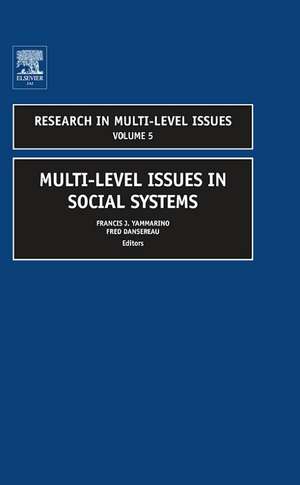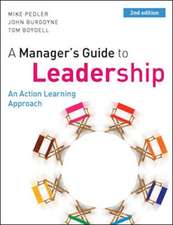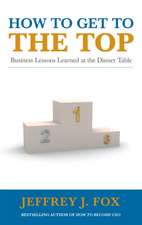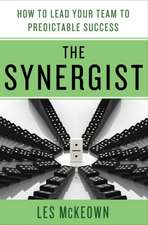Multi–Level Issues in Social Systems: Research in Multi Level Issues
Autor Francis J. Yammarino, Fred Dansereauen Limba Engleză Hardback – 14 iun 2006
Preț: 867.45 lei
Preț vechi: 1126.56 lei
-23% Nou
Puncte Express: 1301
Preț estimativ în valută:
165.98€ • 173.32$ • 137.06£
165.98€ • 173.32$ • 137.06£
Carte tipărită la comandă
Livrare economică 15-29 aprilie
Preluare comenzi: 021 569.72.76
Specificații
ISBN-13: 9780762313341
ISBN-10: 076231334X
Pagini: 496
Dimensiuni: 155 x 234 x 660 mm
Greutate: 0.82 kg
Editura: Emerald Publishing
Seria Research in Multi Level Issues
ISBN-10: 076231334X
Pagini: 496
Dimensiuni: 155 x 234 x 660 mm
Greutate: 0.82 kg
Editura: Emerald Publishing
Seria Research in Multi Level Issues
Public țintă
Established scholars in multi-level issues, scholars and researchers new to the field of multi-level studies, and doctoral students in the various disciplines where multi-level issues are being pursued.Cuprins
Overview: Multi-level Issues in Social Systems (F. Dansereau and F. J. Yammarino).
Part I: Human Resources Management: Multi-level Fit. An Integrative Framework for Understanding Human Resources Management Practices in Cross-cultural contexts (K. A. Aumann and C. Ostroff); An organizational perspective on multi-level cultural integration: Human Resource Management Practices in Cross-cultural Contexts (X. Chen and A. Tsui); Integrating HRM Practices into a Multi-level Model of Culture: Culture’s Values, Depth and Strength.(M. Erez); Multi-level Fit: Complexity, Values and Climate (K. A. Umann and C. Ostroff). Part II: Continuous Learning: Continuous Learning in Organizations: A Living Systems Analysis of Individual, Group, and Organization Learning (M. London and V.I. Sessa); Continuous Learning: Why is it Still an Issue? (D. V. Day and B.W. Tate); A Multi-level Inquiry and Elaboration: Continuous Learning Within and Across Organizations, Groups, and Individuals. (S. E. Markham, R. L. Groesbeck, and B.R. Swan); Continuous Learning About Continuous Learning: Clarifying and Expanding a Multi-level, Living Systems Analysis (V.I. Sessa and M. London). Part III: Divorce and Family: The Importance of the Common Family Background for the Similarity of Divorce Risks of Siblings: A Multi-level Event History Analysis (J. Dronkers and J. Hox); Sibling Effects on Divorce: Common Family Background, Common Genetic Heritage, or Continuining Interaction Among Adult Siblings (M.P. Farrell); Multi-level Event History Analysis for a Sibling Design: The Choice of Predictor Variables (T.A.B. Snijders); Additional Thoughts About the Importance of Common Family Background for the Similarity of Divorce Risks of Siblings (J. Dronkers and J. Hox); Part IV: Industry-University Dynamics: Industry-University Intellectual Property Dynamics as a Multi-level Phenomenon (M. Jelinek); Industry-University Relationships and the Context of Intellectual Property Dynamics: the Case of IBM (M.L. Baba); Industry-University Technololgy Transfer: Moving the Research Agenda Forward (M. Feldman); Industry-University Intellectual Property in Context: Framing the Deal and Dealing with the Frame(s) (M. Jelinek). Part V: Organizational Leadership: The Lampe Theory of Organizational Leadership (K. D. Mackenzie);"Breaking the Frame" Even Farther: Complexity Science and Lampe Theory (M. Uhl-bien and R. Marion). Some Ideas about Testing Processual Theories (K.D. Mackenzie). Part VI: About the Authors.
Part I: Human Resources Management: Multi-level Fit. An Integrative Framework for Understanding Human Resources Management Practices in Cross-cultural contexts (K. A. Aumann and C. Ostroff); An organizational perspective on multi-level cultural integration: Human Resource Management Practices in Cross-cultural Contexts (X. Chen and A. Tsui); Integrating HRM Practices into a Multi-level Model of Culture: Culture’s Values, Depth and Strength.(M. Erez); Multi-level Fit: Complexity, Values and Climate (K. A. Umann and C. Ostroff). Part II: Continuous Learning: Continuous Learning in Organizations: A Living Systems Analysis of Individual, Group, and Organization Learning (M. London and V.I. Sessa); Continuous Learning: Why is it Still an Issue? (D. V. Day and B.W. Tate); A Multi-level Inquiry and Elaboration: Continuous Learning Within and Across Organizations, Groups, and Individuals. (S. E. Markham, R. L. Groesbeck, and B.R. Swan); Continuous Learning About Continuous Learning: Clarifying and Expanding a Multi-level, Living Systems Analysis (V.I. Sessa and M. London). Part III: Divorce and Family: The Importance of the Common Family Background for the Similarity of Divorce Risks of Siblings: A Multi-level Event History Analysis (J. Dronkers and J. Hox); Sibling Effects on Divorce: Common Family Background, Common Genetic Heritage, or Continuining Interaction Among Adult Siblings (M.P. Farrell); Multi-level Event History Analysis for a Sibling Design: The Choice of Predictor Variables (T.A.B. Snijders); Additional Thoughts About the Importance of Common Family Background for the Similarity of Divorce Risks of Siblings (J. Dronkers and J. Hox); Part IV: Industry-University Dynamics: Industry-University Intellectual Property Dynamics as a Multi-level Phenomenon (M. Jelinek); Industry-University Relationships and the Context of Intellectual Property Dynamics: the Case of IBM (M.L. Baba); Industry-University Technololgy Transfer: Moving the Research Agenda Forward (M. Feldman); Industry-University Intellectual Property in Context: Framing the Deal and Dealing with the Frame(s) (M. Jelinek). Part V: Organizational Leadership: The Lampe Theory of Organizational Leadership (K. D. Mackenzie);"Breaking the Frame" Even Farther: Complexity Science and Lampe Theory (M. Uhl-bien and R. Marion). Some Ideas about Testing Processual Theories (K.D. Mackenzie). Part VI: About the Authors.

















